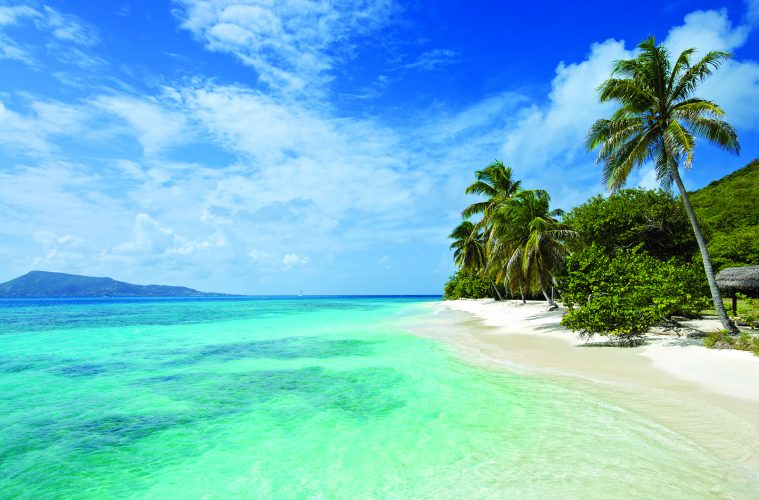Matthew Semark smiles broadly from the wooden dock on the tiny private island of Petit St. Vincent as our boat, The Poseidon, approaches.
“Welcome to Petit St. Vincent,” he says, as we step ashore. Clad in breezy white linen, Semark speaks with a cheerful British accent and holds a wooden tray carrying piña coladas and cold frangipani-scented hand towels. The lush, green island is ringed by white sandy beaches, and a couple of yachts are moored in the aquamarine waters that surround it.
The phrase “private island” is an evocative one, conjuring images of secluded sandy beaches and gentle trade winds that rustle billowy palm fronds. It recalls sparkling, crystalline blue waters and pink, sun-faded conch shells littering the warm sand, in a place where the only sound at night is that of rolling waves and chirping insects.
Yet throughout much of the Caribbean, the realization of escaping to a deserted island is getting harder to find, as mega-resorts and vacation homes pop up throughout the region and tourists descend on places that were once secluded.
At Petit St. Vincent, that fantasy is a reality. The private 115-acre island—located at the southern tip of the Grenadines, an island chain in the West Indies—is home to only the eponymous luxury resort and the Jean-Michel Cousteau Caribbean Diving Center.
Yet even calling Petit St. Vincent—PSV to its many regulars—a “resort” is somewhat misleading, since everything about the island is luxuriously unobtrusive and blissfully low-key. Instead of being housed in a single sprawling building, the island’s accommodations are made up of just 22 one-bedroom cottages and two-bedroom villas that discreetly dot the landscape, tucked into wooded hillsides or nestled along beaches, nearly hidden from view and totally private.
My luggage and a handwritten welcome note are waiting for me when Semark, the resort’s general manager, drops me off at my one-bedroom cottage in his golf cart—the island’s favored mode of transportation. Perched atop a bluff, the airy, vaulted-ceilinged cottage is more like a miniature luxury home, with living room, bedroom, and bathroom constructed of native volcanic stone and purpleheart hardwoods. Floor-to-ceiling sliding glass doors open onto a wide, curving deck, with teak loungers, a swaying hammock, and a minibar stocked with water, coffee, local beers, and even a jar of homemade cookies. The Atlantic Ocean crashes below my sundeck, stretching toward other islands beyond, including Mustique, a favorite of British royalty.
The cottages are blissfully free of televisions, the internet, or even phones—an intercom system lets you reach the resort staff, but not the other way around. In addition, PSV’s charmingly low-tech flag system allows you to communicate with the island staff, who make regular rounds. Raise the red flag on your cottage’s driftwood flagpole to ask for privacy; raise the yellow flag to request service. A hollowed-out tube of wood allows for message-in-a-bottle-style room service requests.
Easygoing, understated luxury suffuses every aspect of life here, without even a whiff of pretentiousness. And with only 22 cottages, PSV is never crowded, even when the resort is full. On the contrary, the island’s beaches are often completely empty, aside from you and your palapa. An hour-long massage at PSV’s Balinese-style hilltop spa, followed by a beach butler-served lunch and a cocktail at West End beach, is about as perfect a day as you can ask for anywhere in the world.
That airy elegance is also the vibe at both of the island’s restaurants: The relaxed Beach Restaurant and Bar hosts evening events like outdoor movies and reggae parties, and the more formal (but still unstuffy) Main Pavilion Restaurant boasts a wine cellar with 4,500 top-tier bottles and an ever-changing menu of dishes like scallops, Black Angus beef, and local spiny lobster.
PSV isn’t just for those looking for relaxation, though. It offers hiking trails, yoga pavilions, and a tennis court, not to mention some of the world’s most pristine coral reefs right in its backyard. It’s no wonder, then, that Jean-Michel Cousteau, son of Jacques, chose PSV for his Caribbean dive outpost. The resort is also committed to conservation.
Even those who don’t dive can experience this rare undersea beauty via a daylong snorkeling expedition. We took the wooden sloop Beauty to Tobago Cays Marine Park, a nature preserve made up of five uninhabited islands where you can swim with green sea turtles, drift over beautiful corals, and spot huge iguanas shading themselves from the hot Caribbean sun on one of the tiny islands. The Beauty’s crew will have an onboard lunch of grilled mahimahi, spiny lobster, fresh tropical fruit, and a bottle of cold Hairoun, a local St. Vincent beer, waiting for you when you return to the sailboat. PSV guests can take to the water in other ways, too, like kayaking, kite surfing, and even a short excursion to Mopion, a perfect, deserted atoll just offshore.
Days later, as the boat speeds me away from PSV and back toward the outside world, I try to etch the image of the island in my mind—the thick green hills rolling toward the white beaches and glittering sea. It’s one last once-in-a-lifetime look at a once-in-a-lifetime place.
Petit St. Vincent

